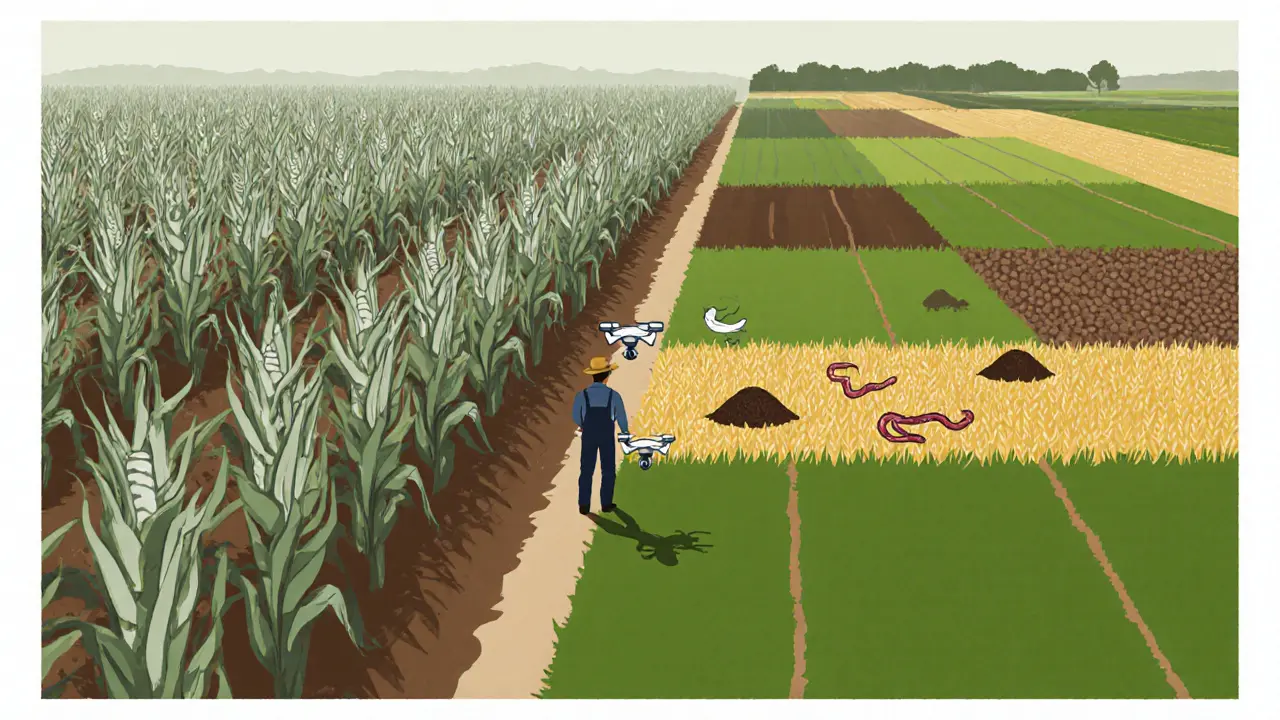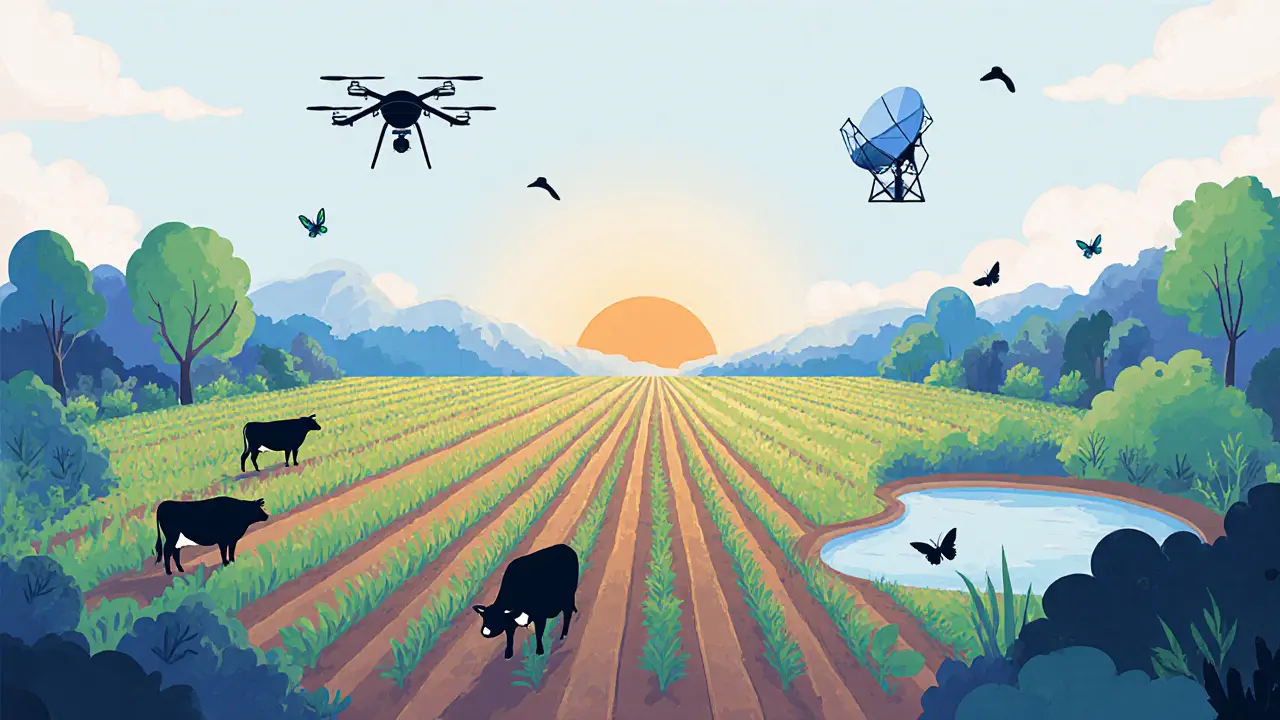Sustainable vs Unsustainable Yield Farming: Pros, Cons, and Real‑World Impact
 Apr, 28 2025
Apr, 28 2025
Yield Farming Impact Calculator
Farm Input Calculator
Impact Assessment Results
Yield Gap
Environmental Impact
Economic Viability
Key Comparison Points
Recommended Path
How This Compares to the Article
Based on your inputs, this reflects the real-world trade-offs between sustainable and conventional farming as discussed in the article. Sustainable approaches typically show smaller yield gaps (around 8-19% depending on practices) but offer long-term soil health benefits and resilience.
When you hear the term Yield Farming is the practice of producing the maximum amount of agricultural output per unit of land, water, or input, you might picture rows of corn or a high‑tech greenhouse. But not all yield farming is created equal. Some approaches chase short‑term harvests at the expense of soil, water, and biodiversity, while others try to blend productivity with long‑term ecosystem health. This guide breaks down the key differences between sustainable and unsustainable yield farming, showing you where the trade‑offs lie and how new technology is reshaping the debate.
What Makes a Yield Farming System Sustainable?
Sustainable Agriculture is a set of practices that maintain or improve soil health, reduce chemical inputs, and preserve ecosystem services while delivering reliable yields. The goal is to keep the land productive for generations, not just the next season. Typical tactics include crop rotations, multi‑cropping, cover crops, reduced tillage, and organic amendments that build soil organic matter.
Characteristics of Unsustainable Yield Farming
Unsustainable systems focus on extracting the highest possible output in the shortest time. They rely heavily on synthetic fertilizers, pesticides, intensive irrigation, and monoculture cropping. While these methods can push yields well above the average, they often ignore the hidden costs: soil degradation, water scarcity, biodiversity loss, and increased greenhouse‑gas emissions.
Yield Gaps - How Much Do Sustainable Practices Lag?
One of the biggest myths is that sustainable farming always means lower yields. Recent meta‑analyses show the average yield gap between organic (a major branch of sustainable agriculture) and conventional systems is about 19.2 % (±3.7 %). However, this gap shrinks dramatically when farms use diversification strategies. Multi‑cropping reduces the gap to roughly 9 % (±4 %), while well‑planned crop rotations bring it down to about 8 % (±5 %). The biggest differences still appear in cereal crops, where decades of Green Revolution breeding have given conventional systems a strong edge.
Environmental Impacts per Unit of Production
When you look at environmental costs per tonne of food, high‑yield systems sometimes perform better. In European dairy, organic farms need twice the land to produce the same amount of milk, leading to one‑third more soil loss. Similar patterns appear in rice and wheat, where inorganic nitrogen can boost yields without adding a proportionate greenhouse‑gas penalty. Dr. David Edwards of the University of Sheffield notes that "organic systems often use more land to produce the same yield, which can increase overall environmental footprints". This aligns with the land‑sparing theory: concentrating production on smaller, high‑yield plots can free up more land for natural habitats.
Economic Viability Over Time
Economics is a decisive factor for farmers. Sustainable farms avoid high certification fees and can tap into premium market prices, but they may face lower short‑term revenues due to yield gaps. Over the long run, however, soil organic matter improvements can raise yields by up to 58 % in sustainable systems, boosting profitability. Conventional farms often see quicker cash flow thanks to higher immediate yields, but they also face rising input costs and potential regulatory pressures.
Resilience to Climate Change
Both approaches are adapting to a warming world, but they do it differently. Sustainable farms build resilience through biodiversity, soil carbon sequestration, and water‑holding capacity. Conventional farms are turning to precision agriculture-satellite imagery, soil‑moisture sensors, and AI‑driven advisory tools-to fine‑tune inputs and respond quickly to stress events. The emerging hybrid models combine these strengths, using tech to enhance the ecological foundations of sustainable practices.
Comparison Table: Sustainable vs Unsustainable Yield Farming
| Aspect | Sustainable Yield Farming | Unsustainable Yield Farming |
|---|---|---|
| Typical Yield Gap | 8‑9 % lower than conventional when using rotation or multi‑cropping | 0 % (maximized) - often exceeds conventional benchmarks |
| Land Use per Unit Output | Higher land requirement (e.g., 2× for organic dairy) | Lower land requirement - higher density |
| Input Costs | Reduced synthetic fertilizers, reliance on compost and cover crops | High synthetic fertilizer & pesticide spend |
| Soil Health | Increased organic matter, better structure, up to 58 % yield boost long‑term | Soil compaction, nutrient depletion, erosion risk |
| Environmental Externalities | Lower greenhouse‑gas emissions per hectare, higher biodiversity | Potentially lower emissions per tonne but higher overall footprint due to land expansion |
| Technology Adoption | Growing use of AI‑driven advisory, precision irrigation | Advanced precision farming, satellite monitoring, automated machinery |
| Climate Resilience | Built‑in buffer via diversified species, carbon‑rich soils | Rapid response via real‑time data, but less inherent buffer |
When Does Sustainable Yield Farming Make Sense?
If your priority is long‑term land stewardship, accessing premium markets, or qualifying for sustainability subsidies, the sustainable route can pay off. Small‑holder farms that can adopt rotation, cover crops, and organic amendments often see steady profit gains after a few years as soil health improves.

When Do Farmers Opt for Unsustainable High‑Yield Systems?
In regions where food security is urgent, where land is abundant but labor is scarce, or where market prices demand maximum volume, high‑input, short‑cycle farming can be the rational choice. Large agribusinesses with access to capital also favor this model to meet contracts and scale quickly.
Hybrid Approaches - The Future of Yield Farming
The binary view of "sustainable vs unsustainable" is fading. Emerging models blend high‑yield techniques with ecological principles: regenerative agriculture uses no‑till, cover crops, and livestock integration to rebuild soil while still delivering competitive yields. Precision tools help apply fertilizers only where needed, cutting waste and emissions. Researchers are developing crop varieties that thrive with lower inputs, aiming to close the yield gap further.
Practical Steps for Farmers Who Want to Shift
- Start with a soil health audit - measure organic matter, pH, and compaction.
- Introduce a simple rotation (e.g., legume‑cereal‑root crop) to break pest cycles.
- Plant cover crops in off‑season to protect soil and add nitrogen.
- Adopt a basic sensor kit for soil moisture to reduce irrigation waste.
- Explore market premiums for sustainably produced goods, even if yields dip slightly.
These actions can reduce the yield gap while building the ecological foundation for future resilience.
Key Takeaway
There’s no one‑size‑fits‑all answer. The sustainable path offers long‑term soil health, potential premium pricing, and lower per‑hectare impacts, but it may need a modest yield sacrifice up front. Unsustainable high‑yield farming can boost immediate production and lower land use per tonne, yet it risks soil degradation and higher long‑term costs. The sweet spot lies in hybrid systems that blend technology with ecological practices, aiming for high yields without abandoning stewardship.
What exactly is a yield gap?
A yield gap is the difference between the potential yield a crop could achieve under optimal conditions and the actual yield obtained by a farmer. It reflects factors like soil health, input use, and management practices.
Can sustainable farms ever out‑yield conventional ones?
Yes, especially when they incorporate advanced practices like precision irrigation, high‑quality organic amendments, and diversified cropping. Some studies show yield gaps shrinking to under 10 % after a few years of soil rebuilding.
How does land‑sparing differ from land‑sharing?
Land‑sparing concentrates production on high‑yield farms, leaving more untouched land for nature. Land‑sharing spreads lower‑intensity farming across larger areas, mixing production with wildlife habitats. The debate centers on which approach reduces overall biodiversity loss while feeding the population.
What role does technology play in sustainable yield farming?
Tech helps monitor soil moisture, nutrient levels, and pest pressure in real time. AI recommendations can suggest the exact amount of compost or water needed, cutting waste and keeping yields high without relying on synthetic chemicals.
Is it financially risky to switch to sustainable practices?
There can be an initial dip in income due to lower yields or certification costs. However, many farms recover profitability within 3‑5 years as soil health improves and they capture price premiums for eco‑friendly products.
Kevin Johnston
October 24, 2025 AT 14:02Dr. Monica Ellis-Blied
October 24, 2025 AT 20:54Herbert Ruiz
October 25, 2025 AT 15:30Saurav Deshpande
October 26, 2025 AT 11:56Paul Lyman
October 27, 2025 AT 09:20Frech Patz
October 28, 2025 AT 05:02Derajanique Mckinney
October 28, 2025 AT 07:59Rosanna Gulisano
October 29, 2025 AT 02:40Sheetal Tolambe
October 30, 2025 AT 02:06gurmukh bhambra
October 30, 2025 AT 04:59Sunny Kashyap
October 30, 2025 AT 21:00james mason
October 31, 2025 AT 17:40Anna Mitchell
October 31, 2025 AT 20:08Pranav Shimpi
October 31, 2025 AT 23:11jummy santh
November 1, 2025 AT 06:21Kirsten McCallum
November 1, 2025 AT 23:56Henry Gómez Lascarro
November 2, 2025 AT 14:09Will Barnwell
November 3, 2025 AT 08:04Lawrence rajini
November 4, 2025 AT 03:05